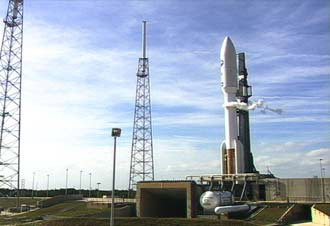Launch of NASA's Pluto Probe Delayed for 24 Hours

A NASAspacecraft destined for the planet Pluto must wait one more day after highwinds prevented a Tuesday launch attempt from Florida's Cape Canaveral AirForce Station.

"We chosenot to launch today because the ground winds were just a bit too high," NASAspokesperson Bruce Buckingham said after the scrub announcement. "The windlimit at the pad is 33 knots [and] we have exceeded that limit several timestoday."
NASA now plansto launch New Horizons Wednesday at 1:16 p.m. EST (1816 GMT), Buckingham added.
High windsprompted flight controllers to delay today's launch several times. The LockheedMartin-built Atlas 5 rocket was initially set to carry New Horizons spaceward at1:24 p.m. EST (1824 GMT), but the ever-present winds pushed the space shotdeeper into its launch window.
Intelevision coverage provided by NASA TV, clouds whipped across the skies abovethe New Horizons-Atlas 5 vehicle as wind blew across treetops surrounding thelaunch pad.
Glitcheswith an Atlas 5 vent valve, a ground tracking station in Antigua and NASA'sDeep Space Network also led to launch delays, though the wind concerns wereomnipresent throughout those issues.
"Spacescience is almost the ultimate in the delayed gratification," NASA chiefMichael Griffin told reporters at NASA's Kennedy Space Center (KSC) before thelaunch attempt.
Get the Space.com Newsletter
Breaking space news, the latest updates on rocket launches, skywatching events and more!
For NewHorizons mission scientists and managers, 'delayed gratification' is anunderstatement.
The $700million mission is the first ever aimed at Pluto, its moon system and the icy KuiperBelt objects that sit in the outer solar system. The mission weathered severalbudgetbattles and fundinghunts during the long road to the launch pad.
About thesize of a grand piano, the 1,025-pound (465-kilogram) spacecraft carries sevenprimary instruments powered by a radioisotopethermoelectric generator (RTG), which converts heat from decaying plutoniuminto electricity.
"We'reraring to go," New Horizons principal investigator Alan Stern,of the Southwest Research Institute, said before the scrub.
Stern saidthat today's launch attempt was significant for himself and the New Horizons missionto Pluto. It marked the anniversary of the death of Clyde Tombaugh,the astronomer who discoveredPluto using Flagstaff, Arizona's Lowell Observatory in 1930.
"He diednine years ago today, almost to the hour of our [planned] launch," Stern said.
Tombaugh'swidow Patsy and children, now grown, attended today's attempted space shot,NASA officials said.
Despitetoday's wind problems, flight controllers reported no problems with the NewHorizons spacecraft itself and are confident the probe will launch before itswindow runs out.
"We have areally good spacecraft," Stern told SPACE.com in an earlier interview. "Areally good spacecraft."
Join our Space Forums to keep talking space on the latest missions, night sky and more! And if you have a news tip, correction or comment, let us know at: community@space.com.

Tariq is the Editor-in-Chief of Space.com and joined the team in 2001, first as an intern and staff writer, and later as an editor. He covers human spaceflight, exploration and space science, as well as skywatching and entertainment. He became Space.com's Managing Editor in 2009 and Editor-in-Chief in 2019. Before joining Space.com, Tariq was a staff reporter for The Los Angeles Times covering education and city beats in La Habra, Fullerton and Huntington Beach. In October 2022, Tariq received the Harry Kolcum Award for excellence in space reporting from the National Space Club Florida Committee. He is also an Eagle Scout (yes, he has the Space Exploration merit badge) and went to Space Camp four times as a kid and a fifth time as an adult. He has journalism degrees from the University of Southern California and New York University. You can find Tariq at Space.com and as the co-host to the This Week In Space podcast with space historian Rod Pyle on the TWiT network. To see his latest project, you can follow Tariq on Twitter @tariqjmalik.









